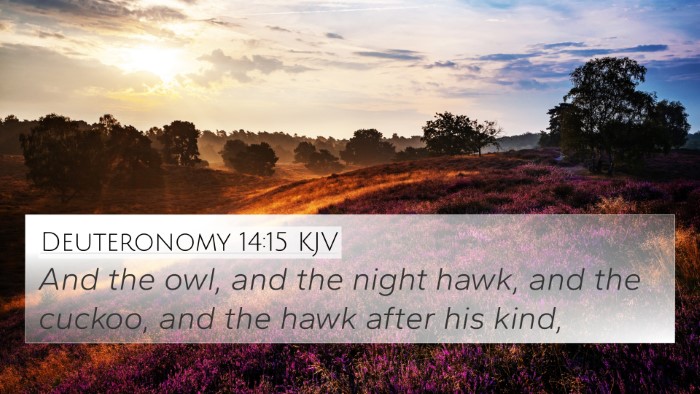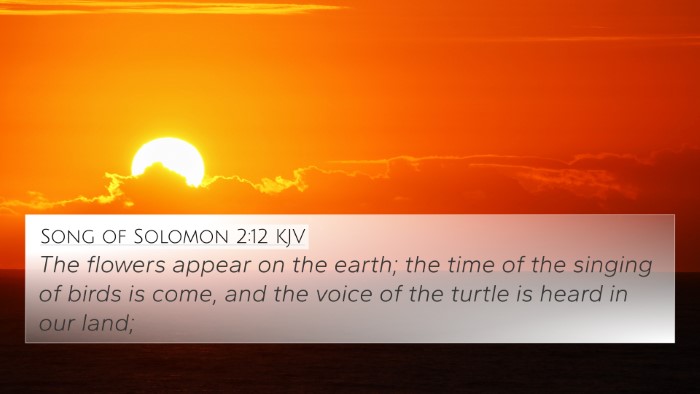Old Testament
Genesis Exodus Leviticus Numbers Deuteronomy Joshua Judges Ruth 1 Samuel 2 Samuel 1 Kings 2 Kings 1 Chronicles 2 Chronicles Ezra Nehemiah Esther Job Psalms Proverbs Ecclesiastes Song of Solomon Isaiah Jeremiah Lamentations Ezekiel Daniel Hosea Joel Amos Obadiah Jonah Micah Nahum Habakkuk Zephaniah Haggai Zechariah MalachiJob 39:26 Similar Verses
Job 39:26 Cross References
Doth the hawk fly by thy wisdom, and stretch her wings toward the south?
Uncover the Rich Themes and Topics of This Bible Verse
Listed below are the Bible themes associated with Job 39:26. We invite you to explore each theme to gain deeper insights into the Scriptures.
Job 39:26 Cross Reference Verses
This section features a detailed cross-reference designed to enrich your understanding of the Scriptures. Below, you will find carefully selected verses that echo the themes and teachings related to Job 39:26 KJV. Click on any image to explore detailed analyses of related Bible verses and uncover deeper theological insights.

Leviticus 16:11 (KJV) »
And Aaron shall bring the bullock of the sin offering, which is for himself, and shall make an atonement for himself, and for his house, and shall kill the bullock of the sin offering which is for himself:

Deuteronomy 14:15 (KJV) »
And the owl, and the night hawk, and the cuckoo, and the hawk after his kind,

Song of Solomon 2:12 (KJV) »
The flowers appear on the earth; the time of the singing of birds is come, and the voice of the turtle is heard in our land;

Jeremiah 8:7 (KJV) »
Yea, the stork in the heaven knoweth her appointed times; and the turtle and the crane and the swallow observe the time of their coming; but my people know not the judgment of the LORD.
Job 39:26 Verse Analysis and Similar Verses
Understanding Job 39:26
Job 39:26: "Doth the eagle mount up at thy command, and make her nest on high?"
Overview of Job 39:26
This verse is part of a series of rhetorical questions posed by God to Job. It emphasizes God’s sovereignty over creation, highlighting His control over all creatures, including the majestic eagle. In this verse, God asks Job if he can command the eagle to soar to great heights, which indicates that God alone has the authority and power to direct the natural world.
Commentary Insights
-
Matthew Henry:
Matthew Henry views this passage as illustrative of God’s unique omnipotence. He notes that the eagle's ability to fly high represents those who are elevated by God’s design, thus pushing the reader to reflect on their own lack of control over creation. The metaphor of the eagle also serves to signify strength and vision, suggesting that God's creations operate under His divine authority.
-
Albert Barnes:
Albert Barnes interprets this verse as demonstrating God's sovereign command over all creatures. He emphasizes that the eagle, known for its lofty flying, does not act on the behest of man but under God's command. This serves as a reminder of humanity's position in relation to the Creator, reinforcing that God has made the eagle and possesses dominion over it.
-
Adam Clarke:
Adam Clarke provides a deeper look into the behaviors of eagles, explaining how their nesting high in the cliffs illustrates a natural instinct placed within them by the Creator. He reflects on the eagle as a symbol of freedom and the heights to which it ascends, correlating this with the spiritual heights believers are called to achieve in their own lives by following God's will.
Key Themes and Connections
This verse can be understood within the thematic context of God's control over nature and His ability to provide for and direct His creatures. Understanding Job 39:26 allows for cross-referencing other biblical texts that similarly address themes of divine authority and creation.
Cross-References
- Psalms 104:30: "Thou sendest forth thy spirit, they are created: and thou renewest the face of the earth." This verse parallels the idea of God's creative power.
- Matthew 6:26: "Behold the fowls of the air: for they sow not, neither do they reap, nor gather into barns; yet your heavenly Father feedeth them." This highlights God's care for His creation.
- Isaiah 40:31: "But they that wait upon the Lord shall renew their strength; they shall mount up with wings as eagles..." This connects the idea of spiritual elevation with the eagle's flight.
- Proverbs 30:18-19: "There be three things which are too wonderful for me, yea, four which I know not: The way of an eagle in the air..." This acknowledges the mystery of God's creations.
- Psalms 91:1: "He that dwelleth in the secret place of the most High shall abide under the shadow of the Almighty." This verse reflects the safety and high position given by God.
- Jeremiah 49:16: "Thy terribleness hath deceived thee, and the pride of thine heart, O thou that dwellest in the clefts of the rock..." relates to the high nesting of the eagle.
- Revelation 12:14: "And to the woman were given two wings of a great eagle, that she might fly into the wilderness..." Alludes to the protective nature represented by the eagle.
Applications and Reflections
Job 39:26 invites us to consider our own understanding of authority and control in our lives. In a world where we often seek to assert our independence, this verse serves as a reminder of God's profound power. Believers are called to recognize their dependence on God, just as the eagle depends on the elements created by God for its soaring flight.
Conclusion
This exploration of Job 39:26 through the lens of biblical commentaries and cross-references enriches our understanding of God's sovereignty and the instilled behaviors of creation. As we engage with this scripture, we are encouraged to look to the Creator, acknowledging His authority over all things while also striving for the spiritual heights He beckons us toward.
Resources for Further Study
If you wish to delve deeper into understanding cross-references, consider tools like a bible concordance or a bible cross-reference guide. These resources can assist in identifying connections between Old and New Testament writings and support your study with bible reference resources and comprehensive cross-reference materials.


